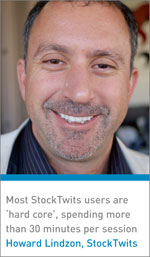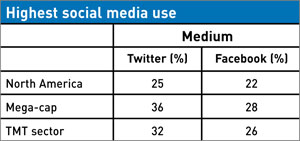A look at why institutional investors have started using social media
Social media present a classic chicken-and-egg dilemma: IROs want to be on Twitter and Facebook – but only if investors are there, too.
And it’s notoriously difficult to determine how many institutional investors are using social media outlets, and whether these new outlets are just sources of entertainment or serious tools for making investment decisions.
No one knows the number of professional investors using social media because most people are consumers rather than sharers, observes Joshua Brown, vice president of investments at Fusion Analytics Investment Partners and author of the Reformed Broker blog.
‘Almost everyone at a buy-side company or an independent of some stripe is on Twitter,’ says Brown, who has 23,000 Twitter followers of his own. ‘It doesn’t mean they’re tweeting, but they are listening.’ Howard Lindzon, a former hedge fund manager who’s now CEO of StockTwits, argues that many institutional investors are ‘sneaking around at the office’, concealing their reliance on social media because the tools are not yet mainstream.
Howard Lindzon, a former hedge fund manager who’s now CEO of StockTwits, argues that many institutional investors are ‘sneaking around at the office’, concealing their reliance on social media because the tools are not yet mainstream.
Lindzon estimates that of StockTwits’ 200,000 users, 30 percent to 40 percent have day jobs as investors. In addition, he notes that most StockTwits users are ‘hard core’, spending more than 30 minutes per session on the site.
When asked about the prevalence of investors using social media, Lindzon responds: ‘It’s everybody now, all the time. If they’re blocked at the office, they’re going home and checking Facebook or using their iPhone to check StockTwits.’
And he should know because it’s applications like StockTwits – a service that mirrors Twitter but exists on its own platform – that are making the endless sea of noise from social media more meaningful for investors.
Psychology of sentiment
Nowadays, news often breaks on Twitter before it hits traditional outlets, says Robert Peck, president of CoRise Co, a digital media-focused merchant bank. ‘If you see a lot of people on Twitter talking very negatively about RIM shares, and then RIM shares start to decline an hour later, you can see investors are harnessing the data on StockTwits or Twitter,’ he says.
Most investors don’t use Twitter to determine which investments to buy, but it can confirm (or quash) hunches. Peck notes that if throngs of salespeople at a certain company are suddenly updating their LinkedIn pages ‘it doesn’t mean the quarter is a disaster or they’re going to lose their jobs, but it does give investors a reason to start asking questions.’
For Brown, Twitter has supplanted traditional news sources. He no longer has a Dow Jones or Reuters newswire subscription because he feels his personally culled Twitter stream gives him superior intelligence.
‘Big quant funds use social media the most,’ says Richard Peterson, a psychiatrist and managing director of MarketPsych Data, based in Santa Monica, California. Just how much is hard to know, he maintains, because quants are so secretive.
Cracking China’s social media marketEric Jackson, founder of Ironfire Capital, a long/short and corporate governance-focused investment firm, is a social media darling in the US with 8,000 followers on Twitter. But in China, where Jackson’s comments are translated into Chinese by translation software, he’s arguably a superstar. On Sina Weibo, a Chinese social media outlet that’s been described as a cross between Twitter and Facebook, he has 17,000 followers. ‘For some reason, I have a lot more followers on Sina Weibo than I have here,’ Jackson says with bemusement.He points out that Chinese social media are mirroring the US, with Renren and Kaixin001 emerging as the Chinese doppelgangers for Facebook. In China today, there’s even an equivalent of StockTwits. Although Twitter is blocked in China, Sina Weibo exceeded 200 mn registered users in the first quarter of 2012, with an average day seeing more than 100 mn messages sent across the platform. By contrast, Twitter has more than 140 mn active users as of 2012, and generates more than 340 mn tweets daily. The number of social media website users in China is impressive, but growth could be hampered by politics. In April, Sina Weibo and another popular micro-blogging service, Tencent, were blocked by China’s government for allowing rumors to spread about a possible coup attempt in Beijing that never materialized. This follows on the heels of an edict from the Chinese government that all users of micro-blogging sites must be registered in their real names – a measure believed to be an attempt to curb rumor-mongering. |
Derwent Capital, a London-based hedge fund with a model that uses information gleaned from Twitter and Facebook to make investment decisions, will soon make its platform available to retail investors and traders who want to gauge collective sentiment this way. Paul Hawtin, Derwent’s CEO and founder, says investors accept that ‘fear and greed’ drive markets, but until now no one has had the technology or data ‘to be able to quantify human emotion.’
Social media, he believes, can do just that, so he’s convinced online channels will play ‘an ever-increasing role within the investment community.’
Some establishment investors are using social media, too, although it’s still common practice to ban them from the workplace. In late 2011 Raymond James partnered with Actiance to let the firm’s financial advisers use LinkedIn, Facebook and Twitter. The brokerage firm offers training sessions to help newbies use social media properly, and allows advisers to share their own ideas on these outlets (once the messages have gone through a screening process).
Brown also praises Bill Gross and PIMCO for their Twitter feed and split-second reactions to economic events. ‘That’s the second-largest investment management company on the planet, and it’s on social media, sharing ideas,’ he enthuses.
Curating information
Social media – with multiple voices speaking freely – can be utter chaos. What’s making it valuable for institutional investors is start-ups creating ways to cut through the noise and extract value. StockTwits did it by coding certain messages with a dollar sign.
Gnip, a provider of social media data for various enterprise applications, is tailoring information for specific industries and has created Gnip MarketStream for hedge funds and high-frequency traders, according to Seth McGuire, director of asset management and financial technology at Gnip. While investors have used social media for everything from news analysis to equity research over the past few years, McGuire says beginning in mid-2011 the primary adoption has been as a trading indicator.
Meanwhile, Estimize is helping institutional investors reimagine one of the coziest and hardest to penetrate corners of the investment world: earnings estimates for public companies.
The IRO viewWhen it comes to social media’s use and value to IR, the jury is most definitely still out among IROs. Dedicated smartphone/tablet apps, an innovation more recent thansocial media, are viewed as more productive, according to IR Insight, the research arm of IR magazine, which conducts polls of the IR community. Even among these groups, however, social media are not considered that useful, being given a productivity score on a scale of one to 10 ranging between four and five, while smartphone apps score between 6.8 and 7.8, and dedicated IR web pages score more than eight. |
Estimize’s chief executive and co-founder Leigh Drogen, who was once a trader and hedge fund analyst, has created an open-source repository for publishing earnings estimates. Of the site’s 6,000 users, 17 percent identify themselves as members of the buy side and 3 percent as members of the sell side.
‘We wanted to open up this data set, which is essentially a closed data set owned by Thomson Reuters’ First Call,’ says Drogen. Estimize finds its participants are beating the pros: for earnings estimates on Estimize with four or more people weighing in, the Estimize numbers were more accurate than the Wall Street consensus 64 percent of the time.
Anonymous donors
Here, too, curating information – or separating the wheat from the chaff – is critical. Drogen lets Estimize users contribute under a pseudonym as long as the pseudonym stays the same. This means other users can check out the accuracy scores of contributors before deciding whether or not to trust their analysis.
‘It leverages the community and says, What do you think the real earnings numbers are?‘ Peck says of Estimize. ‘This is not just the numbers the analysts put out there for the company to easily beat.’ Determining which investment voices to trust remains a problem, even with a multitude of fixes emerging. Some rely upon an individual’s follower count on Twitter; others look to Klout scores, a system of measuring influence in the digital universe by calculating factors such as how frequently an individual’s tweets are retweeted.
Determining which investment voices to trust remains a problem, even with a multitude of fixes emerging. Some rely upon an individual’s follower count on Twitter; others look to Klout scores, a system of measuring influence in the digital universe by calculating factors such as how frequently an individual’s tweets are retweeted.
Whatever method is used, however, people like Brown would argue that social media are a better source of information than reading the financial press or watching CNN, where an editor or producer determines which opinions get aired.
‘People who have a publicist get on television,’ explains Brown. ‘It doesn’t mean they’re necessarily good or smart – or right. Social media, on the other hand, really are a meritocracy.’










